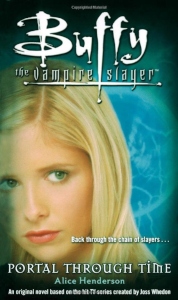With all the possibilities for Buffy to meet past Slayers introduced in “Tales of the Slayer” and the TV series itself, the time-travel adventure “Portal Through Time” (October 2006) should be a lot better than it is. But Alice Henderson, in her only Buffyverse work in the main novel line (she also wrote “Night Terrors” in the “Stake Your Destiny” series), writes in a basic YA style wherein the author’s plotting needs override the Scoobies’ decision-making, thematic statements and even storytelling logic.
The book’s strong point is Henderson’s knowledge of history. Buffy, Giles, Xander and Willow travel from 1998 to four points in the past: Wales, during a Druids-versus-Romans clash in the year 60; Sumer, the most ancient civilization, in 2700 B.C., Tennessee, during a Civil War battle in 1862; and Paris, during the French Revolution in 1792. At the book’s end, Buffy quips that maybe she’ll pass history this school year, and I also soaked up enough pieces of knowledge – such as scribes writing on wet clay tablets in the Sumerian city — to not make “Portal Through Time” a total waste.
Buffy meets the Slayer of each of these points in time (Incinii, Ejuk, Agatha and Marguerite) – aiming to stop time-traveling vampires from killing the Slayer – but these girls don’t make as much of an impression as those in most “Tales of the Slayer” entries. For a deeper French Revolution yarn, for example, check out Nancy Holder’s “Unholy Madness” in “Vol. 1.”
Although she’s most interested in, and best at, writing about historical periods, Henderson spends the first 65 pages of this 332-page novel setting up her rules of time travel. Thanks to vampire ringleader Lucien’s artifact located in Sunnydale, and magickal incantations possessed by both Lucien’s team and Giles, the rules are simple: Read the incantation to open the portal to the past time and date, and read another one to return to 1998 Sunnydale.
But the logic of how Lucien’s team is or is not able to change the future is nutty. Their goal is to wipe out the events of “Prophecy Girl” (1.12), thus allowing the Master to be freed and to open the Hellmouth. In a thematically tidy interpretation of the saga – wherein Buffy is a special Slayer (that’s why her story is being told, as opposed to some other Slayer) – it makes sense that killing Buffy would be the key to changing history.
Weirdly, that’s not the case in “Portal Through Time.” Lucien’s hench-vamps kill a pre-Slayer Buffy twice on short hops back in time, but when they return to 1998 Sunnydale, the Master has not risen and opened the Hellmouth. Even with Buffy dead, the Master’s prophesied rise didn’t happen.
So Lucien devises a plan to kill the Slayer at those four points in history, thinking that will throw off the Slayer lineage so much that the Master will not be stopped. This is ridiculous on the face of it. If the elimination of Buffy herself isn’t enough to change events, then why would the elimination of other Slayers change events? It would be like if the Terminator kills Sarah Connor but that doesn’t change the future, so then he goes back and kills other people and that does change the future.

In the best of the four time hops (inasmuch as it deals with a core “Buffy” relationship), Buffy is forced to kill Angelus. When the Scoobies travel back to 1998 Sunnydale, the Hellmouth has been opened and it’s Hell on Earth. Angel had discovered Lucien’s plan in the original timeline, so without him there, Lucien’s plan has gone off without a hitch. (Then the gang goes back again to fix things.)
Henderson tries to have it both ways: She uses the rubber-band, “snapping back” theory of timelines to explain why the Master is always thwarted even if Buffy is killed before becoming the Slayer. But then the author sets aside that reasoning for the sake of Lucien’s plan, and for the reveal that Angel is crucial to the flow of events. Mirroring what Buffy and others say at various points in “Portal Through Time,” thinking about the “logic” of time travel too much makes my head hurt. But without digging deeply into it, it seems Henderson has slapped together some time-travel rules and a nutty villainous plan in order to get into the historical tales she’s really interested in.
Henderson uses shallow traits to characterize our heroes – Xander being quippy, for instance – and she often adjusts what we know about them in order to fit her storytelling needs. The most extreme example is that Giles is a brilliant linguist, able to communicate even with the ancient Sumerians. In the TV series, he’s certainly the most versed in languages among the Scooby Gang, but he’s never shown to be this skilled.
Because of such shortcuts and simplifications, “Portal Through Time” reminds me of works where pop-culture icons are used to introduce kids to scholarly or worldly subjects. For example, C-3PO and R2-D2 teaching kids about computers, or Superman instructing kids to say no to drugs. Despite the beefy page count and remarkable moments of violence – such as toddler Buffy being slaughtered — this is a kids’ book, with broad history lessons. As a YA novel, it’s not terrible, and it might appeal to ages 12-14, roughly. But it wasn’t pitched as a YA book, since the YA and adult novel lines had merged into one – nominally adult – line four years prior.
We see the marketplace and legal system of a Sumerian walled city, the warfare strategies of the Romans in conquering an island, the bloodthirsty nature of French revolutionaries, and the horrific stupidity of Americans killing Americans. Aside from a nice detail here and there, these lessons will feel cursory to adult readers. Like every aspect of “Portal Through Time,” even the observations about history only operate on a surface level.
Click here for an index of all of John’s “Buffy” and “Angel” reviews.

